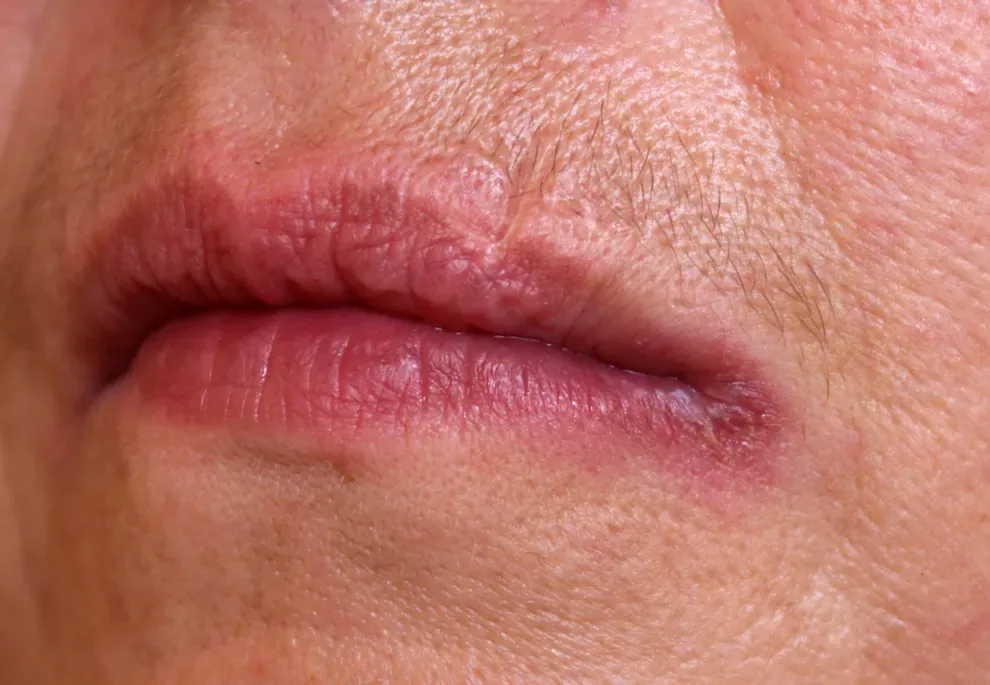Angular Cheilitis: Causes, Symptoms, and Treatment

Table of Contents
- Symptoms
- Risk Factors
- Causes
- Diagnosis
- Other Causes
- Treatment
- Prevention
- References
Angular cheilitis is a condition of swollen red patches in the corners of your mouth. Patches develop where your lips meet and spread at an angle.
Also known as angular stomatitis or perleche, angular cheilitis can occur on one side of your mouth, or both.
Angular cheilitis is a common condition of the skin and can lead to cracked, painful sores. Some people mistake this condition for cold sores. But cold sores are caused by a herpes virus and are contagious. Angular cheilitis is not contagious.
You can treat angular cheilitis by changing your diet, taking medication or using special skin ointments.
Symptoms of Angular Cheilitis
Symptoms of angular cheilitis include:
Redness
Bleeding
Painful fissures/cracks
Crusting
Oozing
Erosions
Blisters
Soggy, lighter-colored skin or Maceration
Swelling
It can develop into widespread candidiasis or impetigo on other skin surfaces.
Who Is at Risk of Developing Angular Cheilitis?
Angular cheilitis usually affects the very young or the very old. Older persons who wear dentures, or experience sagging skin at the corner of their mouth will often suffer from dry mouth corners. Young children who suck on a pacifier, their thumbs, or who drool can also irritate the mouth area where angular cheilitis develops.
Others who are at risk for developing angular cheilitis are persons with certain health conditions, such as:
Diabetes
Inflammatory bowel disease
Down syndrome
HIV or other immune system disorders
Low levels of Vitamin B, proteins, or iron
Smoking
Stress
Skin wrinkles caused by age
Those who experience rapid weight loss
Causes of Angular Cheilitis
Angular cheilitis develops when saliva collects at the corner of your mouth and dries out, causing your skin to dry also. If the area continues to dry out, the skin will crack and allow bacteria or fungi to grow inside of the cracked area.
Bacteria and fungi can cause inflammation and infection. Reasons or conditions that set the stage for dry lip areas include:
Wearing dentures that do not fit your mouth
Yeast of fungal infections in the mouth, such as thrush
Skin allergies
Sucking on a pacifier or your thumb
Wearing a face mask
Eczema or atopic dermatitis
Drooling in your sleep
Misaligned teeth
Diagnosis of Angular Cheilitis
Primary healthcare providers and dermatologists typically diagnose angular cheilitis. To reach a conclusive diagnosis, doctors:
Perform a physical examination
Check your symptoms
Review your medical history
They likely will take a mouth swab to test for a virus, such as herpes or other fungal infections. They may draw blood to determine if you suffer from nutritional deficiencies or other illnesses.
What Else Can Cause Cracked Lip Corners?
Besides having angular cheilitis, you can develop cracked lip corners because of personal habits, environmental factors or a mild condition, such as the common cold or dehydration.
Typically, this condition is not serious and does not affect your overall health, but it can be painful or uncomfortable. Bleeding sometimes accompanies the cracked and dry skin.
Environmental Causes include:
Dry weather
Cold weather
Wind exposure
Indoor heating
Sun damage
Other Causes of Cracked Lip Corners include:
Low red blood cell count
Yeast infection
Viral respiratory infection
Frequent wetting of the lips
Vitamin B deficiency
Allergic reaction to lip balms or lipstick
Breathing through the mouth
Cold sores
Mild dehydration
Cracked mouth corners can be a sign of severe dehydration, although this is rare. Severe dehydration is a life-threatening condition and requires immediate medical attention.
Treatment for Angular Cheilitis
Treating angular cheilitis depends on the causes. Among the most common medical treatments are:
Any hardware in your mouth, such as dentures, should fit properly. If you have misaligned teeth or bite, it needs to be corrected with headgear, retainers, or braces by a dental professional.
Topical or oral antibiotics can treat bacterial infections.
Some foods, such as those rich in proteins, vitamin B, and iron can clear up issues caused by a lack of nutrients or a poor diet.
Topical steroids or antifungal creams can relieve swelling and pain from a cracked mouth corner. It may also be recommended you use petroleum jelly or lip balm to keep your mouth moisturized and protected.
Prevention of Angular Cheilitis
Most of the causes for angular cheilitis are unavoidable, but you are able to reduce your risk or help prevent its occurrence by:
Avoiding contact with skin irritants and allergens
Eating healthy and drinking a lot of water
Keep your lips moisturized
Do not smoke or use other tobacco products
Do not lick or wet your lips
Do not use expired cosmetics
